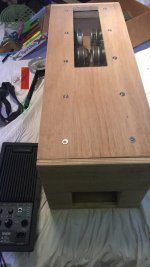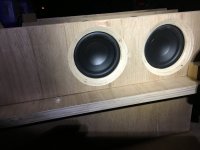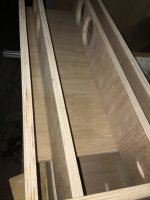I'm still looking for the "best" cabinet for my 12-280 8W woofer from Thomann (as described in this thread: https://www.diyaudio.com/community/...as-with-12-280-8-w.383285/page-2#post-6949739).
I sort of had dismissed tapped horns because of size, but a Tham12 comes in pretty close to my size-limit, so curiosity got the best of me and I started drawing/simulating a looot of TH-cabinets with actual internal volume up tp 75Liter. - some pretty efficient options in that range, BUT the boring downside is that I can make a HR-sim that gives almost exactly the same response for a 6th order parallel bandpass (within the same cabinet volume). I´m assuming that a TH would win if cabinet-size was not a constraint, but it is.
So, the question for this thread is: assuming that a 6th order parallel bandpass (HR: BP6P) and a TH are the same volume (60-80Liter in this case) AND have approx. the same FR and diaphragm displacement, which is better? Cooling must be better in a TH, but construction is also more complicated and heavier due to the internal path.
Looking at impulse responses for both systems, I cannot see which is better.
Use-case is indoor, small, party-setup. Lower knee (-3dB) can as high as 50Hz). must work up to 150Hz. Power around 200-300W
Kind regards TroelsM
I sort of had dismissed tapped horns because of size, but a Tham12 comes in pretty close to my size-limit, so curiosity got the best of me and I started drawing/simulating a looot of TH-cabinets with actual internal volume up tp 75Liter. - some pretty efficient options in that range, BUT the boring downside is that I can make a HR-sim that gives almost exactly the same response for a 6th order parallel bandpass (within the same cabinet volume). I´m assuming that a TH would win if cabinet-size was not a constraint, but it is.
So, the question for this thread is: assuming that a 6th order parallel bandpass (HR: BP6P) and a TH are the same volume (60-80Liter in this case) AND have approx. the same FR and diaphragm displacement, which is better? Cooling must be better in a TH, but construction is also more complicated and heavier due to the internal path.
Looking at impulse responses for both systems, I cannot see which is better.
Use-case is indoor, small, party-setup. Lower knee (-3dB) can as high as 50Hz). must work up to 150Hz. Power around 200-300W
Kind regards TroelsM
I am probably biased towards tapped horns, they work well and there is lots of good design guides online to help optimize the designs. I find it quicker and easier for me to design a good tapped horn than a parallel or series 6th order, but the parallel and TH should really be equivalent or really close if enclosure volumes and tunings are the same. A series 6th order should at better than the parallel or TH, unless you didn't spend enough time tweaking the design.
I think TH are pretty easy to build, once you sort out the design and folding of course. Long skinny designs need bracing though!
The bandpass will be easier to adjust after it is built than the TH for sure though.
I wouldn't build either without actually measuring the T/S parameters of the woofer you have in hand.
I think TH are pretty easy to build, once you sort out the design and folding of course. Long skinny designs need bracing though!
The bandpass will be easier to adjust after it is built than the TH for sure though.
I wouldn't build either without actually measuring the T/S parameters of the woofer you have in hand.
A TH is basically a 6th order series-tuned BP with better cooling for the driver and better linearity at low frequencies (basically zero vent compression), but poorer out-of-band response (while might look Ok in the same, anything above 3*Fb is basically unusable). Getting either of them to do a nice 50 Hz to 150 Hz passband would be an interesting challenge. With that challenge I might opt for a MLTL instead, or even one of the better-designed "paraflex" arrangements, which are basically another approach to dealing with the response dip at 3*Fb when the design involves the use of a large vent and the rear output of the driver.
Oh, I forgot one more thing - because of the all of the internal folding in a TH, the box ends up being a lot better braced than your typical 6th order BP. However, that does not mean that you can get by without bracing a TH. All external panels that are NOT connected to one of the internal panels should be properly braced.
Hi Brian. Thanks for the input. I have zero experience with the paraflex systems, but it appears to me that they cannot be squeezed into the smallish box I'm looking at.A TH is basically a 6th order series-tuned BP with better cooling for the driver and better linearity at low frequencies (basically zero vent compression), but poorer out-of-band response (while might look Ok in the same, anything above 3*Fb is basically unusable). Getting either of them to do a nice 50 Hz to 150 Hz passband would be an interesting challenge. With that challenge I might opt for a MLTL instead, or even one of the better-designed "paraflex" arrangements, which are basically another approach to dealing with the response dip at 3*Fb when the design involves the use of a large vent and the rear output of the driver.
... Getting either of them to do a nice 50 Hz to 150 Hz passband would be an interesting challenge. ...
Yeah, I missed that part. I suspect if you pulled that off the tradeoff to gain would make a ported box look like a good alternative
Looking at the link, if it is modeling in a ported box ~ 40 liters, 75 liters might be optimistic for a higher order box with bracing, ports and driver displacement
Just 'running the numbers', this TH in 75 L net looks OK to me with some HF DSP........Getting either of them to do a nice 50 Hz to 150 Hz passband would be an interesting challenge.
Attachments
Hi GM.
Maybe I'm reading it wrong, but you appear to use a very high value for Le (4.42mH). Where did you find that value? it affects modelling somewhat.
Kind regards TroelsM
Maybe I'm reading it wrong, but you appear to use a very high value for Le (4.42mH). Where did you find that value? it affects modelling somewhat.
Kind regards TroelsM
Greets!
The specs I found at the time listed what all I used, but apparently forgot to bookmark it and now I can only find a completely different set of measurement specs in an owner's manual (that I didn't find last time!) so between a 38 Hz Vs 50 Hz Fs, etc., discrepancy, no clue what its specs might be, so best to measure yours.
Historically though, many inexpensive 'sub' woofers had a very high Le to get more HF BW, so it didn't raise any 'flags' for me.
The specs I found at the time listed what all I used, but apparently forgot to bookmark it and now I can only find a completely different set of measurement specs in an owner's manual (that I didn't find last time!) so between a 38 Hz Vs 50 Hz Fs, etc., discrepancy, no clue what its specs might be, so best to measure yours.
Historically though, many inexpensive 'sub' woofers had a very high Le to get more HF BW, so it didn't raise any 'flags' for me.
Found another set of specs that's similar to what I used except Le = 2.31, so still > 2x the 1.1 Le in the manual.
After countless ( really, too many..) designs in hornresp, Sketchup and Boxplan I've reached a point where I'm either A) building something to stop the endless iterations or B) Abandon the project because I'm moving in cirkles.
(MASSIVE shoutout to HornResp and Boxplan. - How lucky am I to have such tools available as an amateur! Thank you!)
A BR will max out around 95dB/W and as GM´s example shows a TH around 75L can reach around 96-76 average. To me, anything below 96dB/W is not worth the trouble of building (just as well do a boring BR). As a top-tier reference TH-mini from Danley does 100dB/W in a almost similar box.
Although I initially tried to keep the internal box-volume below 65L, I've come to accept 85L as max, - including all ports, dividers and other. So effective volume for a TH ends up around 75L. I still aim for 50Hz as -3dB point.
So within these constraints there are quite a few options: Tapped Horn, paraflex, 6th order parallel bandpass (BP6P) and more.
My best simulation so far is a cabinet that can be configured to do a few different things: tapped horn, ParaflexA and BP6P with minimal changes. It started out as a TH-sim in HR and ended up having only right angles and straight cuts. Thus name must be RATH (Right Angle Tapped Horn). That evolved and now the design is a bizarre cross-over so official name shall be SRATH (Smells like Right Angle Tapped Horn).
Further description will follow but for now, here a sketch showing basic build and different configs:

The most promising sim is shown below. I'm building a cab, and hopefully I can test it within the next few weeks. - it will need a active low-pass around 150Hz.
Let me know what you think.

(MASSIVE shoutout to HornResp and Boxplan. - How lucky am I to have such tools available as an amateur! Thank you!)
A BR will max out around 95dB/W and as GM´s example shows a TH around 75L can reach around 96-76 average. To me, anything below 96dB/W is not worth the trouble of building (just as well do a boring BR). As a top-tier reference TH-mini from Danley does 100dB/W in a almost similar box.
Although I initially tried to keep the internal box-volume below 65L, I've come to accept 85L as max, - including all ports, dividers and other. So effective volume for a TH ends up around 75L. I still aim for 50Hz as -3dB point.
So within these constraints there are quite a few options: Tapped Horn, paraflex, 6th order parallel bandpass (BP6P) and more.
My best simulation so far is a cabinet that can be configured to do a few different things: tapped horn, ParaflexA and BP6P with minimal changes. It started out as a TH-sim in HR and ended up having only right angles and straight cuts. Thus name must be RATH (Right Angle Tapped Horn). That evolved and now the design is a bizarre cross-over so official name shall be SRATH (Smells like Right Angle Tapped Horn).
Further description will follow but for now, here a sketch showing basic build and different configs:
The most promising sim is shown below. I'm building a cab, and hopefully I can test it within the next few weeks. - it will need a active low-pass around 150Hz.
Let me know what you think.
Out of those three cabinet options, I'd probably opt for the first one, as there's lots of options there for tuning without having to make major changes.
Nice to see that that the BOXPLAN workbooks are being put to good use. They're all in various stages of development, with some more useful than others. I'm still searching for the "Holy Grail" - a programmatic way to describe a box layout, so I can have "one BOXPLAN to rule them all", rather than a separate BOXPLAN for each type of layout. Alas, I'm still searching... 🙂
Nice to see that that the BOXPLAN workbooks are being put to good use. They're all in various stages of development, with some more useful than others. I'm still searching for the "Holy Grail" - a programmatic way to describe a box layout, so I can have "one BOXPLAN to rule them all", rather than a separate BOXPLAN for each type of layout. Alas, I'm still searching... 🙂
I think all cabs can be realized in the same box with minor adjustment. The green panel to the right will be removable in any case so there's access to the innards.
Kind regards TroelsM
Kind regards TroelsM
Heads up, The paraflex designs are plagued with a phase discontinuity that wants to get really bad in rooms or cars. I think through it parallel arrangement it takes all of those types of problems and really exaggerates them? I got sick of dealing with it, and just went back to the drawing board.
If you look at the sim of any of the models in the area you see up close and personal, what the cone has to deal with in the pressure / velocity details through that whole area . It looks And sounds like it appears. Unhappy potential cone folding scenario, ringing or absent.
After Many cuss words and even bandsawing enclosures open to drop in mass load ing restrictions to fudge the difference between outputs I threw in the towel after finally fixing it and realizing you should remove so much output at the point where it does actually sound really good at that smaller closure would’ve been fine in the first place. the idea and folding sequence are not allowing anything to change.
so, I just went back to bonehead simple . a different approach which is essentially a parallel offset driver dual qw pipe With a series exit and all of that mess is fixed. Almost too well it has all of that unique punch to it but I don’t have an area I’m trying to avoid or second-guess what’s going on around us frequencies because it doesn’t exist.
From 4 x four inch drivers 4x 12s to single 18 it cleans up real nice. It’s no longer a hassle with potential ringing A lot of vibrations and funky residence around that area that shows up in the whole cabinet.
If you look at the sim of any of the models in the area you see up close and personal, what the cone has to deal with in the pressure / velocity details through that whole area . It looks And sounds like it appears. Unhappy potential cone folding scenario, ringing or absent.
After Many cuss words and even bandsawing enclosures open to drop in mass load ing restrictions to fudge the difference between outputs I threw in the towel after finally fixing it and realizing you should remove so much output at the point where it does actually sound really good at that smaller closure would’ve been fine in the first place. the idea and folding sequence are not allowing anything to change.
so, I just went back to bonehead simple . a different approach which is essentially a parallel offset driver dual qw pipe With a series exit and all of that mess is fixed. Almost too well it has all of that unique punch to it but I don’t have an area I’m trying to avoid or second-guess what’s going on around us frequencies because it doesn’t exist.
From 4 x four inch drivers 4x 12s to single 18 it cleans up real nice. It’s no longer a hassle with potential ringing A lot of vibrations and funky residence around that area that shows up in the whole cabinet.
Attachments
I've yet to look at the paraflex[es], but "drop in mass loading restrictions" has me curious, i.e. is the driver chamber sealed or is one side a low pass filter and the other a high pass one or.......?
A paraflex is a BP6S that behaves like a BP6P due to the ports exit. There are no sealed chambers.
Thats a funny way of looking at it, but I think it makes sense 🙂A paraflex is a BP6S that behaves like a BP6P due to the ports exit. There are no sealed chambers.
- Home
- Loudspeakers
- Subwoofers
- Tapped Horn Vs 6th order par.bandpass ?



